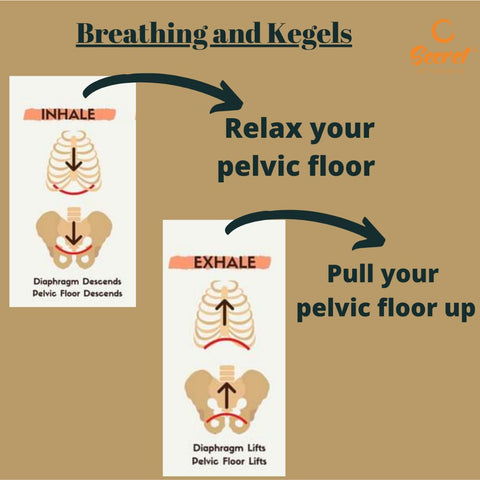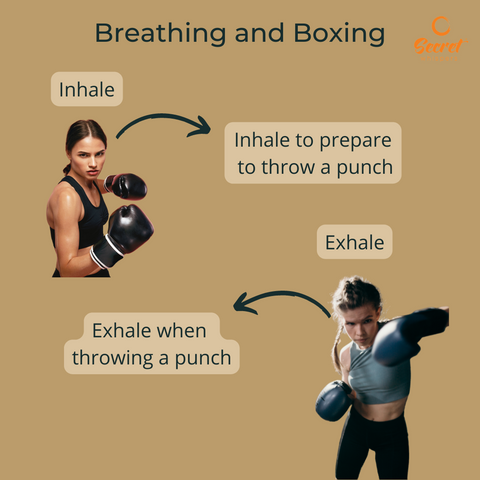How Breathing Can Strengthen Your Pelvic Floor
We all know by now that pelvic floor exercises, or Kegels, are vital for the health and strength of your pelvic floor muscles, but did you know that breathing also plays a key role in keeping your pelvic floor in tip-top condition? (1)
When you inhale, your diaphragm moves down towards the top of your abdomen, which applies increased pressure in this area. This results in the pelvic floor also lowering down, giving it a little stretch for free! When you breathe out, the reverse happens, with the pressure in your abdomen decreasing, and so it continues. It follows therefore, that when you breathe in deeply, your pelvic floor gets a nice little stretch, and unless you breathe out fully, and exhale correctly, your muscles in the pelvic floor area remain in a constant stretch, which may lead to weakening in this area.

Breathing Exercises for Pelvic Floor Muscles
This is all very well, I mean we all breathe without thinking about it. Obviously it is one of the most important things that our bodies do automatically, without us really being aware that it is happening, but what about if breathing exercises could actually help strengthen your pelvic floor muscles? What about if just breathing mindfully for a few minutes a day could ensure that your pelvic floor is functioning at its very best?
A few simple breathing exercises can help. Basically, we need to unlearn and stop breathing the ‘wrong’ way…
That may sound strange. How can we be breathing wrong? I mean, we’ve been doing it for a long time now, right? Our whole lives, in fact! But many of us have developed breathing habits that can cause problems and actually exacerbate our weak pelvic floor, such as taking shallow breaths when we are stressed. Plus, did you know that when you clench your jaw you are tightening your pelvic floor? We do not want a tight pelvic floor either. So watch that jaw clenching!
Take Control of Your Breath
Deepening, relaxing and slowing your breath right down to a steady and natural rhythm can help relax and also put you in the right mind set to try to connect your pelvic floor to your breathing.
Breathe through your nose
Breathing in this way refines and prepares the air that we take in so that it can be used as efficiently as possible. I for one am guilty of breathing through my mouth, and this is a habit many people have developed.
Breathe with your belly
Breathe with my belly?! How on earth am I supposed to breathe with my belly? You just told me to breathe through my nose…..!
Obviously we don’t mean that you should try and rediscover some ancient way of exhaling through your belly button, but your belly is where your diaphragm lives and, according to West Suffolk NHS Trust (2), 70-80% of your breathing should be done by your diaphragm, in order to make sure that your breathing is nice and deep
You can work on belly breathing correctly by laying on your back with one hand on your chest and one on your belly, and noticing which hands rise and fall as you breathe. As you breathe deeply, the hand on your belly should rise as you breathe in and fall as you breathe out.
How to Breathe When Doing Pelvic Floor Exercises
50% of women do not know how to do Kegel exercises correctly, and this is largely because we cannot see OR feel these muscles. Using Secret Whispers Kegel Weights can help teach you where these muscles are and how to effectively do a Kegel exercise.Given that we are struggling to engage these muscles and perform good Kegels, surely we don’t need to think of anything else at the same time?! Actually, yes, you do…
When you are completing your pelvic floor exercises, you need to keep breathing correctly too, in order to help those pelvic floor muscles along the way.
It’s a bit like driving. When you first start to learn, there is so much to think of. The clutch, the gears, steering, indictors. It soon becomes automatic, almost second nature, doesn’t it? In just the same way, it is very common to struggle with doing a Kegel and breathing properly to start with, but you’ll soon get the hang of it!
Like in the breathing exercise detailed above, practice while laying on your back, and focussing on your pelvic floor area and what is happening there. Wearing your Kegel weights while you are doing this can help, and if you are worrying about being able to keep them in, this position will help remove some of the concerns. First, practice the breathing as discussed about, breathing into your belly and try to notice what happens in the pelvic floor area while you breathe in and out. On the inhale, your belly should rise and you should feel a slight pressure on the pelvic floor, then as you exhale gently, your belly should fall (by itself, there’s no need to force it) the pressure should pass. By breathing mindfully, and paying attention to the upward movement of your belly, add in the contraction of a Kegel as you exhale, and relax the muscles as you inhale.
Its important not to get frustrated by doing the Kegel and breathing all at the same time. Relax, Breathe, Focus. You will get there. Secret Whispers 4 Week Workout Programme is a great way get started on your journey to a super fit pelvic floor
We also teach this on our 28 Day Pelvic Floor Challenge - SIGN UP NOW to be notified when the next one is running.
TOP TIP: Think of boxing like the image below. This will help you to remember how to breath correctly when doing pelvic floor exercises.

To find out more, have a look at our other blogs:
Can Stress & Anxiety Cause Urinary Incontinence?
A Step-By-Step Guide To Do Kegel Exercises
A Beginners Guide To Meditation
You can also join our fabulous womens only private Facebook Group
Fancy a freebie? Download our FREE guide The easy way to get a stronger pelvic floor
Any questions? Just email us at support@secretwhispers.co.uk and we will get straight back to you.
Reference websites:
- apextwellness.com/breath-and-your-pelvic-floor
- wsh.nhs.uk/CMS-Documents/Patient-leaflets/Physiotherapy/5242-2Breathing-Control.pdf










